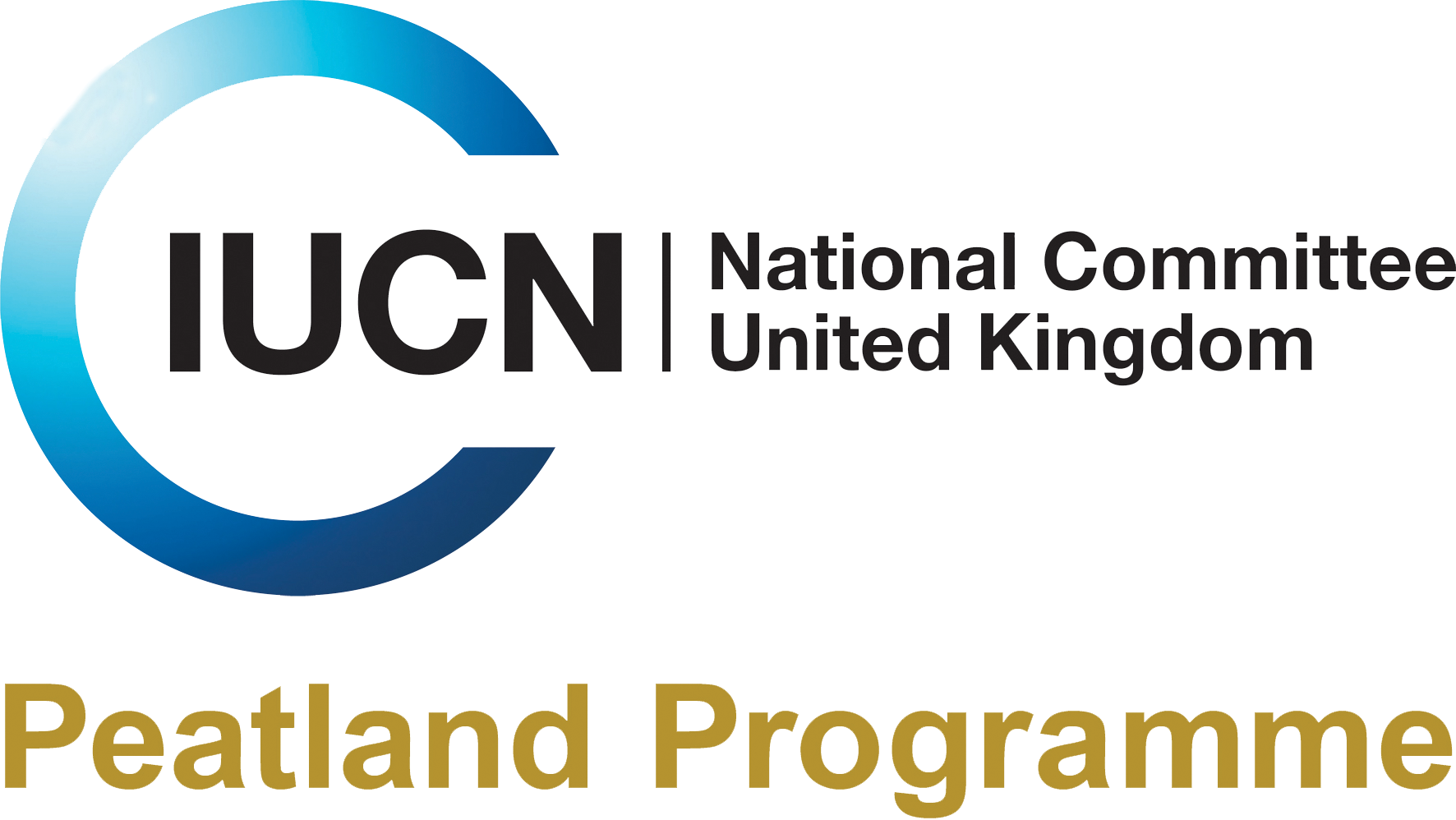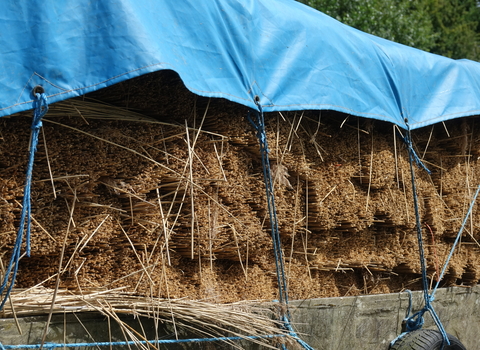Peatlands contain a unique archive of our cultural past.
Peatlands across the world show evidence of being shaped and modified by past human activities, from the influence of prehistoric humans to recent drainage and extraction activities1. Beneath the peat, large tracts of prehistoric landscapes lie protected from modern disturbances. Peat in a wet, healthy peatland is an oxygen-free environment and, in such conditions, artefacts, structures and other evidence of past environments (e.g. insects, shells of micro-organisms, pollen, charcoal, etc.) and past cultures survive for millennia. For information on environmental archives within the peat and paleoecology, please see our palaeoecology webpage.
Preserving our history
Various remains preserved in peat can provide direct evidence of how humans lived in the past, and how they interacted with and modified their environment. Preserved objects such as dwellings, wooden trackways, tools, ceremonial monuments, burial chambers, rock art and even food have been found in the UK1. Some fascinating examples of remains and artefacts from Scotland’s peat bogs can be found on the Dig It! website.
These artefacts and structures can shed light on past agricultural and ritual practices, patterns of settlement and even trade networks. For example, the Star Carr archaeological site in North Yorkshire has revealed the largest collection of Mesolithic bone and antler artefacts in Europe, including possible headdresses made from red deer skulls, thought to be used in shamanic rituals. Another, indirect, source of evidence of past human activity is fossil exoskeletons of insects preserved in peat. The types of insects (e.g. parasites, pests) present in an environment can help us understand what people ate, how food was stored, which farming activities took place, what the sanitation conditions were like and how humans dispersed2.
Neolithic timber trackway made of Scots pine on Hatfield Moors. Credit Henry Chapman
Preserved remains of ancient humans (‘bog bodies’) have also been found in peatlands throughout the UK, the most famous of which is the Lindow Man found in a peat bog in Cheshire. Most bog bodies were discovered during the late 19th and early 20th centuries, although they continue to be found today, and indicate the potential for peatlands to preserve direct evidence of human ancestors3.
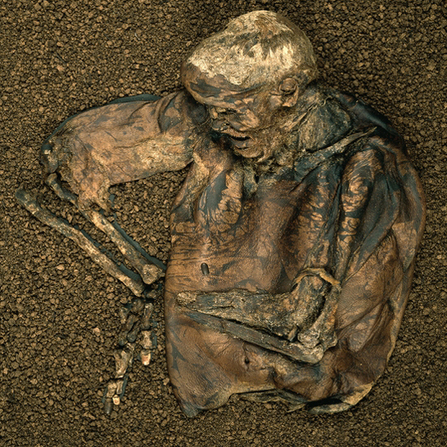
The Lindow Man was found in a bog in Cheshire. Credit British Museum
Preserved remains, structures and artefacts are displayed in museums and archaeological parks around the UK. Flag Fen Archaeological Park. near Peterborough, England, exhibits evidence that the drained peatlands of the area were biodiverse wetlands during the Bronze Age, inhabited by people who built wooden causeways and moved around in boats. The nearby Must Farm settlement revealed five Bronze Age houses raised on stilts above a river. Such sites are important displays of cultural history that help to connect people with peatlands and demonstrate the need for peatland restoration.
The Must Farm Settlement excavation of an exceptionally well-preserved settlement dating to the late Bronze Age (1000 – 800BC) near Peterborough. Credit Henry Chapman
Peatlands also record environmental change, as peat layers of different depths can be dated in palaeoecological studies. This archive includes the history of each particular peatland, in the form of the remains of the plants that make up the peat and of the organisms that lived on the peatland. We can also learn of past changes in the landscape surrounding peatlands, which can be reconstructed from the pollen that blew into them.
Understanding human impacts on peatlands
Peatlands themselves form part of the historic landscape and contain important evidence of peat cutting, which was used as an alternative source of fuel to wood and goes back to the Roman period. Traditionally, peat and turf were cut from bogs using a spade. The cut slices were placed on the surface of the peatland and dried in the sun. The dried peat material was later used as fuel for cooking and heating.
Before the Industrial Revolution, peat cutting was mostly localised, and peat was cut for fuel and bedding for animals. However, in the 19th and 20th centuries, peatlands had been converted to private property by the government, revoking the traditional right to use peatlands freely. Commercial exploitation of peatlands was intensified by the Industrial Revolution, as the need for fuel increased. Peat was also used as litter for horses in growing cities during the Victorian period, and later for horses of the first World War. The industrial scale removal of peat during these times is often why medieval layers of peat are lacking in the UK.
Turf cutting is a practice that continues today, often with help of modern peat cutting machines. The Crofters Act in Scotland gives crofts the right to cut peat at small scale. In Ireland, people with turbary rights can cut turf for personal use as affordable fuel. For many, turf cutting is a way of life and a part of their cultural heritage. Today, just over 1% of the population in Ireland use turf for heating their homes4, and this number is declining as people transition to renewable forms of energy. Recognising the importance of healthy peatlands, cleaner air and reduced CO2 emissions, the Irish government now aims to transition away from turf cutting practices and introduced a ban on the commercial sale of turf in 2022.
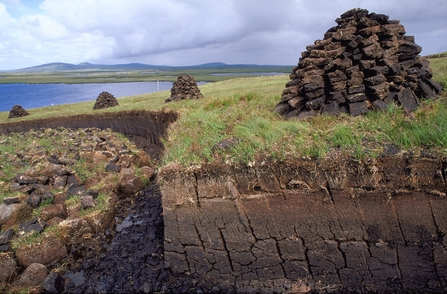
Peat cutting and stacking on North Uist. Credit Lorne Gill/NatureScot
Another historical practice - tin streaming - has left evidence in the peatlands of South West England, which is still visible today. Tin streaming is the extraction of tin from the mineral cassiterite, which is found as seams in the underlying granite in Dartmoor and Cornwall. Other types of mineral extraction, such as lead mining in the North (e.g. Pennines) and in Wales has left similar evidence in the peatland landscapes. This was done by hushing – using a flood of water to expose mineral veins before extracting them.
Reviving past traditions for a sustainable future
Reeds harvested from fens have a long history of being used as roofing material. Thatched roofs were dominant in many towns and villages in the English countryside until the late 1800s5. Reed is an established paludiculture or ‘wet farming’ crop and is extensively harvested on a commercial basis6. Paludiculture offers a shift in lowland peatland agriculture, and the potential to return to traditional land management, including historical land use practices such as growing and harvesting of reedbeds7. The UK currently imports 95% of its reed. Locally grown reed would provide employment and has a smaller carbon footprint6.
Reed has other potential uses as well. The fluffy seed-heads of bulrush reed can be used to make insulation products for houses, filling for clothing or sustainable packaging. ‘Peatland Progress: A New Vision for the Fens’ is a project that is trialling paludiculture crops, including bulrush, in the Cambridgeshire Fens.
Another craft using traditional wetland products was willow weaving to produce baskets traditionally used for domestic, industrial, agricultural and fishing purposes. However, what was once an important part of the UK’s cultural heritage is now in danger of being lost, as the users and markets for these baskets inevitably change over time - see the report on Endangered Baskets in the UK for more information.
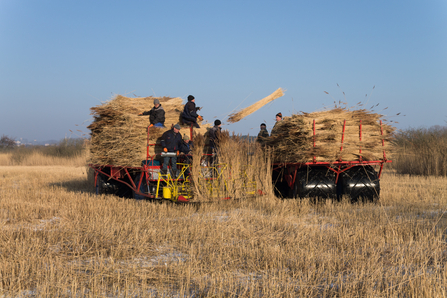
Harvest of reed in Mecklenburg-Western Pomerania. Credit Tobias Dahms
Peatlands in folklore, art and literature
Peatlands are often depicted in folklore as inhospitable, dangerous or ‘other-worldly’ places8. Prior to the 18th century, moorlands were regarded with distaste and as best avoided. Such perceptions have influenced art and literature – think of the Grimpen Mire in ‘The Hound of the Baskervilles’ or wild northern moors in novels written by the Brontë sisters. These perceptions are also reflected in the negative connotations of words related to peatlands in the English language. For example, to lag behind, being swamped, getting bogged down, or to be mired in a problem.
Later, drainage and degradation of peatlands for agricultural use ‘domesticated’ these landscapes and reduced the concept of danger. Excellent examples of peatlands in art dating back to the 19th century can be found on the Discipline-Hopping Peatlands & Wetlands website.
More recently, the way we think about and engage with peatlands has started to change, as the value of these landscapes in the face of the climate emergency is increasingly recognised. This change in contemporary cultural perceptions is also starting to be reflected in popular culture, as artists are becoming inspired by these environments in different ways9. Peatlands and their capacity to store carbon have inspired sculptures and performances, combining art and science, such as Sticky Sculptures by the artist Manon Awst. Peatlands have also featured in poetry such as Annemarie Ní Churreáin’s Bog Medicine.
Peatlands and ‘sense of place’
Peatlands provide many people with a ‘sense of place’. As large seminatural landscapes, they dominate all but two of our 15 UK National Parks and can provide local communities with a sense of inspiration and connectedness with their natural environment. Peatlands have come to be regarded and valued as wilderness in some places. Elsewhere, however, peatland landscapes have been formed through the centuries-long utilisation of the peat itself, and this activity has contributed to the way communities understand peatlands. The challenge ahead is to manage peatland use in ways that minimise the damage and to look at economic and employment opportunities. These include recreation and tourism (e.g. hill walking) or work in peatland restoration with volunteers and contractors to optimise the biological, cultural and economic value associated with healthy peatland habitats.
Archaeology and peatland restoration
It has been estimated that more than 20,500 archaeological sites exist beneath and within the peat in the UK3. Peatland degradation and exploitation has played a role in bringing some of these incredible archaeological finds to the surface. On the other hand, many artefacts have been damaged and unknowingly lost due to the drying and degradation of the peat that preserved them. Historic features preserved in peat require stable, wet, undamaged and undisturbed habitats if they are to survive over the long term1. With around 80% of UK peatlands in a degraded state, valuable historic remains can be lost. However, if peat restoration activities are not carefully planned, they can also introduce changes to – and potential loss of – archaeological remains1.
The England Peat Action Plan sets out the role that peatland restoration schemes play in recognising, supporting and enhancing the public value of the historic environment within peatlands10. Ensuring that the historic environment is considered when restoring peatlands will allow land managers to make the most of peatland habitats and our heritage10. The importance of preserving archaeological remains is increasingly recognised in peatland conservation and restoration. For example, the South West Peatland Partnership currently have three archaeologists as part of their team, which ensures archaeology is given the consideration it deserves.
Historic England and Natural England have also published guidance to support peatland restoration projects. The guidance emphasises the importance of avoiding or minimising damage to historic environment features and implementing mitigation schemes. Well planned restoration projects can provide the benefits of improved ecosystem services whilst preserving archaeological remains.
Resources and guidance
Natural England worked with Wessex Archaeology to create a historic environment peatland ‘toolbox talk’ to act as an introduction to management of archaeological finds when restoring peatlands. The video below refers to English legislation and systems, with some reference to Wales. The content includes an interview with a peatland contractor who has found archaeological items in England, explores the type of archaeological finds that might be discovered during works, and what to do in case of unexpected finds.
The following video is a recording of the ‘Cultural heritage and peat’ workshop that took place at the IUCN UK Peatland Programme 2023 conference. This workshop provided perspectives from across the UK in relation to regulation, the work of heritage contractors and the value of archaeology in engaging people with peatland restoration.
- Guidance for Peatland Restoration and the Historic Environment in Scotland
- Lecture by Henry Chapman on bog bodies and peatland heritage - video
- Horsey Wetland Farm Trial: paludiculture and reed harvesting - video
- Historic England Protecting Peat Bogs and Peatlands
- Historic England Research Reports
- Historic England 2016 Preserving Archaeological Remains: Decision-taking for Sites under Development [plus 5 appendices]
References
1. Historic England. Peatlands and the Historic Environment: An Introduction to their Cultural and Heritage Value. Historic England. 2021. https://historicengland.org.uk/images-books/publications/peatlands-and-historic-environment
2. Elias S.A. The Use of Insect Fossils in Archeology. Developments in Quaternary Sciences. 2010; 12: 89-121. https://doi.org/10.1016/S1571-0866(09)01207-X
3. Gearey B., Bermingham N., Chapman H., Charman D., Fletcher W., Fyfe R. et al. Peatlands and the Historic Environment. IUCN UK Peatland Programme. 2010.
4. Central Statistics Office. Census of Population 2022 Profile 2 - Housing in Ireland. https://www.cso.ie/en/releasesandpublications/ep/p-cpp2/censusofpopulation2022profile2-housinginireland/occupieddwellings [Accessed 10th April 2024].
5. Letts J. and Moir J. Thatch: Thatching in England 1790-1940: Pt.1. London: James & James. 1999.
6. CANAPE. Reed. https://northsearegion.eu/canape/paludiculture/reed [Accessed 28th February 2024].
7. IUCN. Principles for Sustainable Paludiculture. IUCN UK Peatland Programme. 2023.
8. Flint A and Jennings B. Saturated with meaning: peatlands, heritage and folklore. Time and Mind. 2020;13(3): 283-405.
9. Gearey B., O’Connor M. and Everett R. How art inspired by peatlands can help us confront the climate crisis. https://theconversation.com/how-art-inspired-by-peatlands-can-help-us-confront-the-climate-crisis-199752 [Accessed 28th February 2024].
10. Natural England and Historic England. Peatland restoration and the historic environment: Standards for delivering environmentally sustainable peatland restoration projects. Natural England, Version 2. 2022. https://historicengland.org.uk/images-books/publications/peatland-restoration-historic-environment
